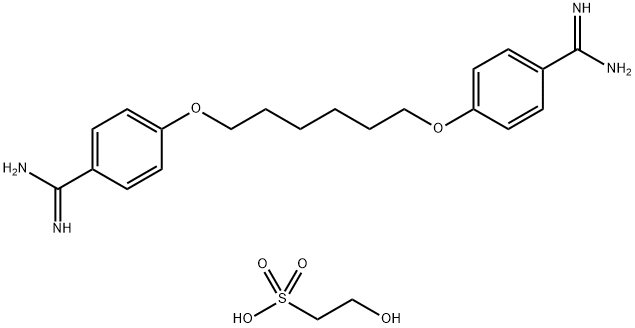Hexamidinediisethionate , Analysis of the control products , 659-40-5
Synonym(s):
Hexamidine diisetionate
CAS NO.:659-40-5
Empirical Formula: C22H32N4O6S
Molecular Weight: 480.58
MDL number: MFCD04112907
EINECS: 211-533-5
| Pack Size | Price | Stock | Quantity |
| 100mg | RMB528.00 | In Stock |
|
| others | Enquire |
PRODUCT Properties
| Melting point: | 246-247° (dec) |
| Density | 671[at 20℃] |
| vapor pressure | 0Pa at 20℃ |
| solubility | Sparingly soluble in water, slightly soluble in ethanol (96 per cent), practically insoluble in methylene chloride |
| Water Solubility | 48.2g/L at 20℃ |
| InChIKey | NBVZMBLJRHUOJR-UHFFFAOYSA-N |
| SMILES | C(CO)S(O)(=O)=O.O(C1C=CC(C(N)=N)=CC=1)CCCCCCOC1C=CC(C(N)=N)=CC=1 |
| LogP | 4.47 at 25℃ |
Description and Uses
Hexamidine diisethionate (HEX D) is an organic salt form of Hexamidine, which has been used as an antimicrobial agent in the personal care industry and in a variety of over-the-counter (OTC) products. For example, 0.05% HEX D solution (Keratosept?) is a new antimicrobial drop for the treatment of eye infections and is better tolerated than povidone iodine. In personal care, Hexamidine has adverse reactions such as photosensitivity and contact allergy. Therefore, the European safety assessment recommends that the content of HEX D in leave-on and rinse-off cosmetics should not exceed 0.1%[1-2].
Hexamidinediisethionate is a preservative in topical preparations and also in skin health and personal care products.
Safety
| Symbol(GHS) |  GHS07 |
| Signal word | Warning |
| Hazard statements | H302 |
| Precautionary statements | P264-P270-P301+P312-P330-P501-P273-P391-P501 |
| RIDADR | 2811 |
| WGK Germany | 3 |
| HazardClass | 6.1(b) |
| PackingGroup | III |



